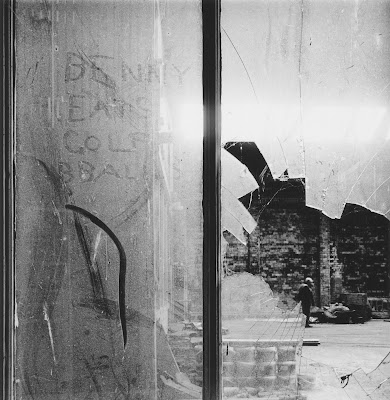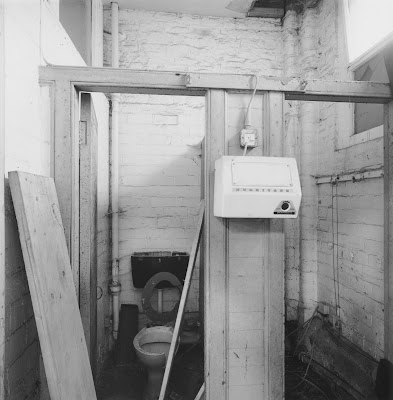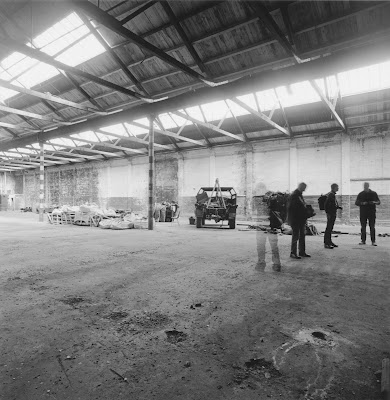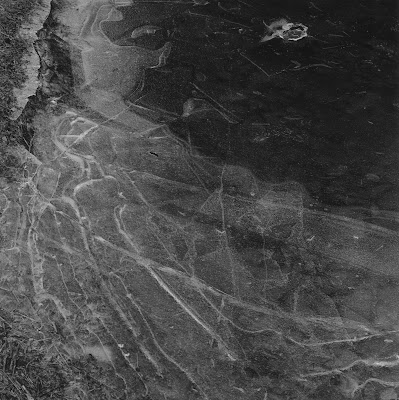Morning folks - I have to admit that I have been quite tearful recently.
And why's that? you might ask, and I'll tell you . . .
Muuuuum!! It was that Bruce from The Online Darkroom. Muuuuummmmm!
 |
| Ilford FP4+ At Work |
But first let me explain myself - I was recently incredibly lucky to be allowed, properly allowed, inside a derelict building.
No mincing about making sure the rozers haven't seen you . . . oh no, someone actually opened the door! The place was Dundee's Maryfield Tram Depot and for nearly all of its life from 1901 to 1956 it was just that - a massive hangar in which to store trams.
When the trams were decommissioned it saw life as a property for corporation buses and then reached an ignominious end in the hands of Scottish Water.
It has been empty/derelict for roughly 20 years and was in a state of potential collapse before it caught the eye of Dundee Transport Museum.
Hopefully, with a TON of cash in the form of funding, and most importantly vision from its board, this wonderful (and large) old building will be brought back to life as just that - a museum that reflects the story of the cities transport systems.
I can't wait.
I have to say I do have an affinity with lovely old places (like the depot) that have been treated really badly.
I dunno, I always feel that there's something of the spirit of the place hanging around in darker corners and eaves and so on, waiting for someone who actually gives a damn to come along and rub their chin and say:
"Well . . . . maybe . . . "
Anyway, a bunch of us from the DCA Photography Forum got a chance to go.
I packed the Hasselblad SW; the Gossen Lunasix-S; a tripod and some FP4 and had a bloody great time.
I got home, eagerly processed the film in Pyrocat-HD and then next day made a contact print and winged a snap of it over to Bruce ('cos we do such things) and awaited his (always) considered, objective and knowledgable opinion . . . . and this is what came winging back and what set me off a-blubbin':
You’re going to hate me, Phil, but I think digital is better suited to photographing the interiors of old buildings than film. There, I’ve said it. I spent a while looking at Neil’s (Neil, being another member of the forum) pictures and your contact sheet and I can’t really see any advantages from film.
Take the “comparison” pics I’ve attached - and I know yours is just a contact so it’s very unfair. But do you see yourself being able to get as much detail and micro contrast out of that scene? That Leica must be some camera as I don’t think I’d have got results like Neil’s from the D700. Neil obviously knows his way around Photoshop or whatever but I think he stays on the tasteful side of editing. The highlights in his comparison pic are spot on I think, loads of detail but light enough that you get the sense of the contrast between the darkness in the building he’s standing in and the adjacent building. Did he use a bit of HDR right enough? If so, he’s done it well. The texture in that scene is amazing. You can see the unevenness on the surface of every brick.
You’re going to have a job getting something like that out of the FP4 because film is HARD compared to digital. In the recent past I might have dismissed the digital shots as, “Well, yeah, that’s the computer doing all the work.” But just concentrating solely on the images and not thinking about the processes, then digital produces better results in most cases. I think that’s what’s changed for me: I’m now more concerned about the print in my hand rather than how it got there. Yes, there’s all the tradition behind film, Minor White, Ralph Gibson, Ansel, etc, but the reality is that these guys used film because it’s all they had and most would have used digital had it been available to them. You’re presumably using MF for sharpness and a lack of grain but digital does that much better. If you use 35mm for grain and a (comparative) lack of sharpness then you’re playing to film’s strength. Basically, digital does MF better than MF but film does 35mm better than digital.
Here's two of Neil's photographs - he was using a Leica M 240 and 21mm Elmarit.
 |
| © Neil Robertson |
 |
| © Neil Robertson |
They're good aren't they, and even rather film-like - especially the second one.
Hmmmm - was The Robbins right?
Two boxes of Man-Size Kleenex and a day later, I was still upset; so much so that I sobbed all the way to the darkroom.
I had to prove something to myself, because I respect Bruce's opinion and his judgements of both image and print making. I also respect Neil's photography - he's been doing it for a very long time and has probably used more cameras than you've had hot dinners! And (amongst other things) he's a really good street photographer too.
Anyway, with gritty determination, I fired up the DeVere 504 with the 100mm Vivitar and made some prints.
It can be unusual making 8 prints from a film that only has 12 frames on it, but I was happy with all of them; in actuality I could probably have printed 11, but stuck at 8 as it gets really hard to dry that many big prints in my tiny darkroom - especially so when you're using a caravan retractable clothes line as your hanging source!
My current image size is 8 x 8" on 9.5 x 12" Ilford MGRC Pearl - that will continue as long as I have that size paper left, after which economics will dictate that I revert to 10 x 8".
The developer I used was some truly ancient Adox MG (it had been in one of those soft pack things for at least a couple of years); they were then double fixed and selenium toned.
I'm really happy with them.
They're different to Neil's photos - he bought some really fine inkjet prints of them along to the last meeting and we compared notes.
As I said before, he'd been using a Leica M 240 with a 21mm Elmarit.
To my eyes they look different, yet in some ways quite similar - especially my sixth one down (compared to his first photograph); his camera picked out details on the wall that were virtually invisible to me (my meter reading for those shadows was EV 1) - such is the nature of modern photography!
Anyway, here's my prints - all scans of the original silver gelatin jobs.
I still think MF is a very valid format - OK it isn't all bells and whistles and hyper-reality, but it does a very good job of conveying space and light and atmosphere (though how you can judge that I have no idea).
As with all these things, it is also the process itself that ensures its validity.
I simply wouldn't bother if I were able to check things immediately and then spend the afternoon dealing with them on a computer; I just love the sheer footeriness and downright challenge that Medium Format photography brings; it's a considered and methodical way of doing things to me, and I will continue to do it for as long as I am able.
The thing I would say about MF is, definitely 'professionally' it's as dead as a dodo - you just have to look at the slew of images in this year's Hasselblad Masters competition to realise that THE name in MF, has little interest in its heritage.
And yet, I'll pose you this question . . how come, old Hasselblads, Rolleis, Mamiyas, Bronicas and Fujis STILL keep selling?
They're not exactly cheap these days - in fact if you'd had enough money to buy a bundle of 500C/M bodies back in the heyday (1980's) then you'd be making approximately three times what you paid for them.
Is there really a deep-pocketed army of 'advanced amateurs' keeping this going? Or is it the fact that (like me) people realise that roll film is a wonderful and (dare I say it) therapeutic form of photography, whereby you can enjoy a great deal of the scutter that comes with Large Format, with little of the weight and hassle.
There's no doubt about it, Large Format photography makes you (well it does me) feel like A Photographer.
There's something primal from photography's early days that fires up every time you see an upside down and reversed ground glass . . .
But the thing is, when I am out somewhere wild with the Hasselblad and I've chosen my point of view and composed, locked the mirror up, watched the scene and then squeezed the cable release, that quite and precise whirr of the shutter makes me feel the same way.
I guess it is the Visual Heritage of Medium Format - from Callahan to McKenna (and all points inbetween).
So much incredible photography has been made with roll film, how could you really go wrong?
MF makes me feel like I am walking in some pretty important footprints and more to the point, makes me feel responsible for preserving a legacy that shouldn't just be allowed to be side-lined by advances in technology.
There, I've said it, Medium Format photography isn't dead . . it doesn't even smell funny. As long as 120 film continues to be made, there'll be a bunch of nutters (and I would call myself a chief nut) out there, revelling in the freedom of (sic) a roll of film.
Bruce and I are still friends by the way - I just wish he'd use his film cameras more these days, and whilst he is currently having a whale of a time with his ancient D700, an as-ancient Epson and some old software, he is (still in my opinion and he can disagree as much as he likes) a film photographer at heart (as he might say, whatever THAT may mean these days).
As always, thanks for reading . . . keep on thinking!
H xx














.jpeg)
.jpeg)
.jpeg)
.jpeg)
.jpeg)















